The Salesforce Platform empowers customers to build applications that are highly customized to their particular business operations and data. As platform researchers, we help create the tools that enable customers, including Salesforce administrators, to build these applications. Last year, the platform research team at Salesforce embarked on a project to update our existing UX personas. We had inherited two sets of persona work that described Platform users, but neither was actually being used to guide product-related decisions. One of the projects, the results of a skill segmentation survey, was regarded as accurate and credible, but was reported through dense tables of data and few stakeholders read or referenced it. The other was a more traditional set of personas that was easy to consume, but lacked specificity and was perceived as too superficial to be useful in decision-making. While this original persona work was based in research, it sat underutilized by researchers, designers, and product managers alike.
Our updated personas project actually came to the same, far-reaching conclusion the earlier research had arrived at: we were underestimating the complexity that Salesforce admins face when trying to use our features. However, when we shared the refreshed findings with stakeholders across R&D, including designers, developers, product managers, and technical writers, we earned rave reviews. The deck went viral, repeat performances of the presentation were requested, and teams across the company and beyond R&D were discussing the implications on Chatter (Salesforce’s social network for businesses).

What was the difference? What made this round of personas more successful than the previous? It came down to pairing the great research work (methods, data, analysis, and synthesis) with equally great communication design (the story and corresponding visuals). The previous persona work only had one or the other. Let me break it down further:
Solid Research
It all starts with a solid foundation of robust research insights. This time around, we increased the nuance of our main segmentation questions so that our breakdown of the admin population was more detailed and precise. To avoid the superficial perception that the original, easy-to-consume personas acquired, we highlighted this rigor along with the project’s sample size and confidence level right off the bat. This brought accuracy and credibility to the meat of the project. Additionally, we were able to show how the personas relate to one another. This provided a micro and macro view of our admin users so that stakeholders could both orient themselves within the greater spectrum of our user base and dive deeper when needed.
Focused Verbal Communication
While it was obviously critical to have great content, the packaging of the research was equally important in making the insights digestible by the product organization at large. Keeping this audience in mind, we spent a good portion of the overall project duration crafting a memorable story and visual presentation.
To hone in on the right pitch, we were ruthless about narrowing the story down to a single key message. We learned a lot from this round of research, but we would have risked overwhelming and confusing our audience if we included all of it. When it came to our actual talk, we led with the conclusion. As researchers, it can sometimes feel unnatural to bump the process part of the research cycle, but that typically doesn’t make a compelling story for stakeholders.
Then we focused on the “so what” of the lead insight: What should product managers do with this new knowledge? How does this apply to development teams? As with other research projects in industry, this “so what” element was key to help our stakeholders understand why they should care and how it connects to their personal slice of the world. For us, this translated into explicitly showing stakeholders how they could use these personas: first have a reality check (who is the target segment[s] and how successful are they with widget X), then define corresponding success metrics and work toward closing any gaps.
Compelling Visual Communication
Presentation design went hand-in-hand with the pitch. As much as we researcher-types may love data and spreadsheets, an audience of developers and product managers doesn’t necessarily share the love. Therefore, it was important to lead with the story of each persona and position the data as supporting evidence. These are real people, after all, and people are engaging. Each profile was made up of four parts: a cheeky and visual introduction, a one-page overview, a collection of direct quotes, and an all-encompassing key takeaway.
With the help of one of our multi-talented platform teammates, each introduction featured an illustration of the persona, for example a confident racecar driver for our Accelerated Admins, with an explanatory one-liner to engage our audience’s curiosity.
The one-page snapshots captured several basic details at a glance in a super readable and comparable way.
The direct quotes added color and reinforced the connection to real people.
The key takeaway gave our audience a single nugget of information they could latch onto if they couldn’t remember anything else about the personas.
Throughout the presentation, we also included catchy phrases and taglines to boost the stickiness of the research insights, like “#gladmin” (for successful Salesforce admins), a crowd favorite.
Since the debut of these personas, their reach has gone further than I think even we anticipated: I’ve seen engineering teams reference the different types of admins while discussing the appropriate boundary between two similar features and teams far beyond the product organization have picked it up too. By combining the strengths of robust research insights and killer communication design, we created a shared understanding and language of Salesforce admins that in turn, will help the organization make the right things for the right users. How might thoughtful communication design up the ante on your next research project?

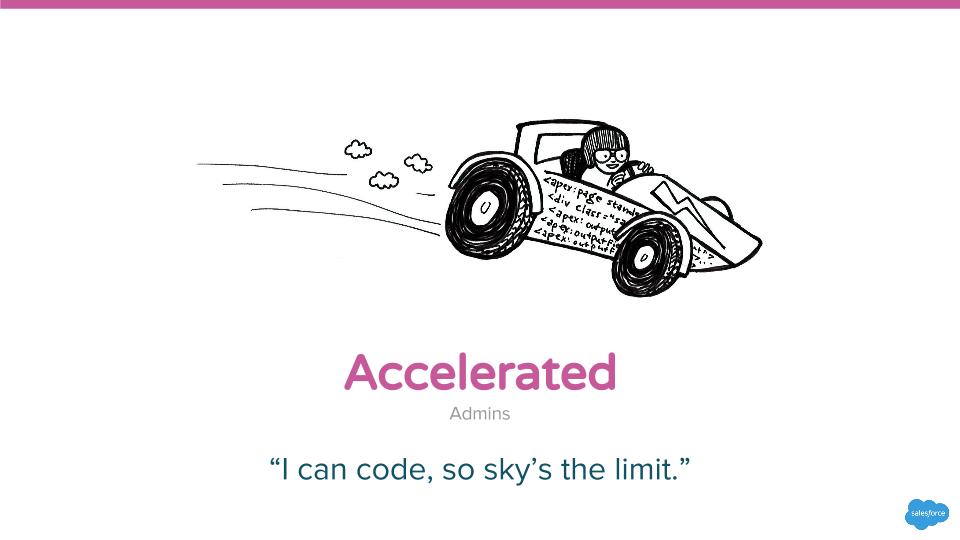
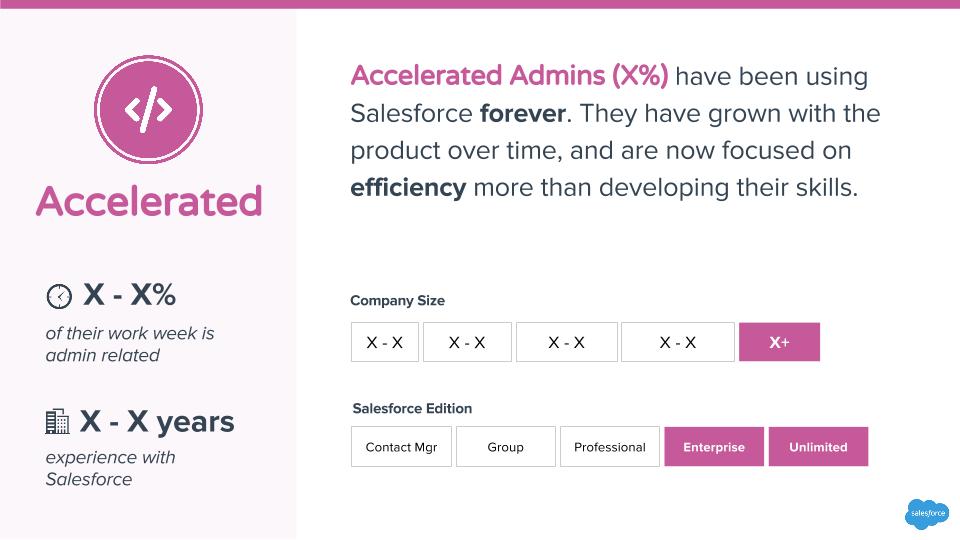
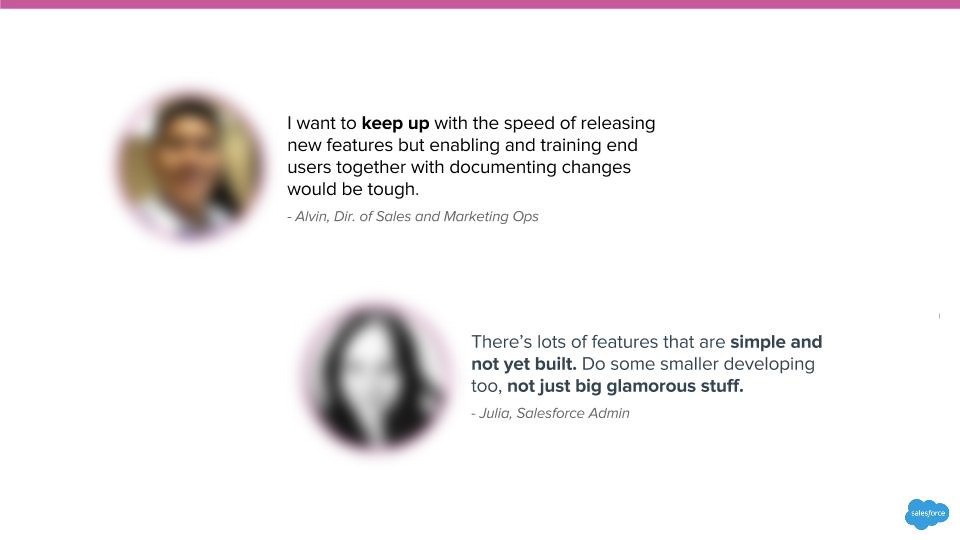
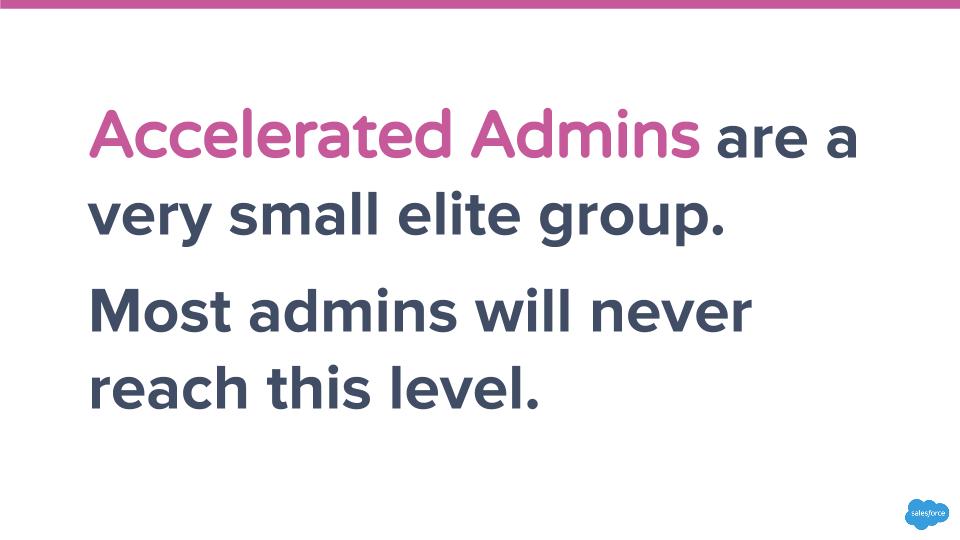
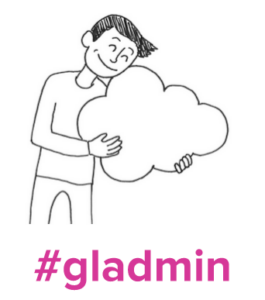

0 Comments